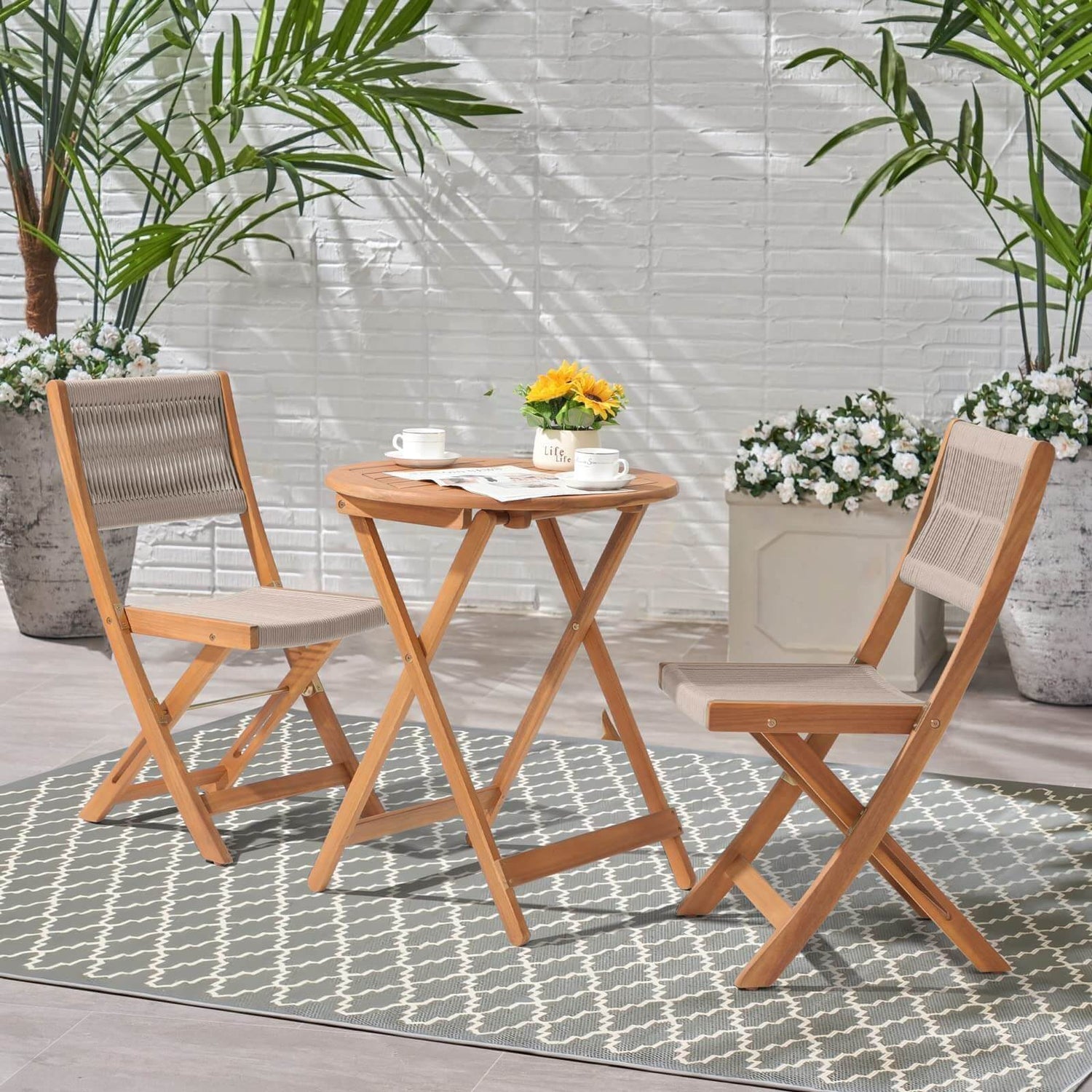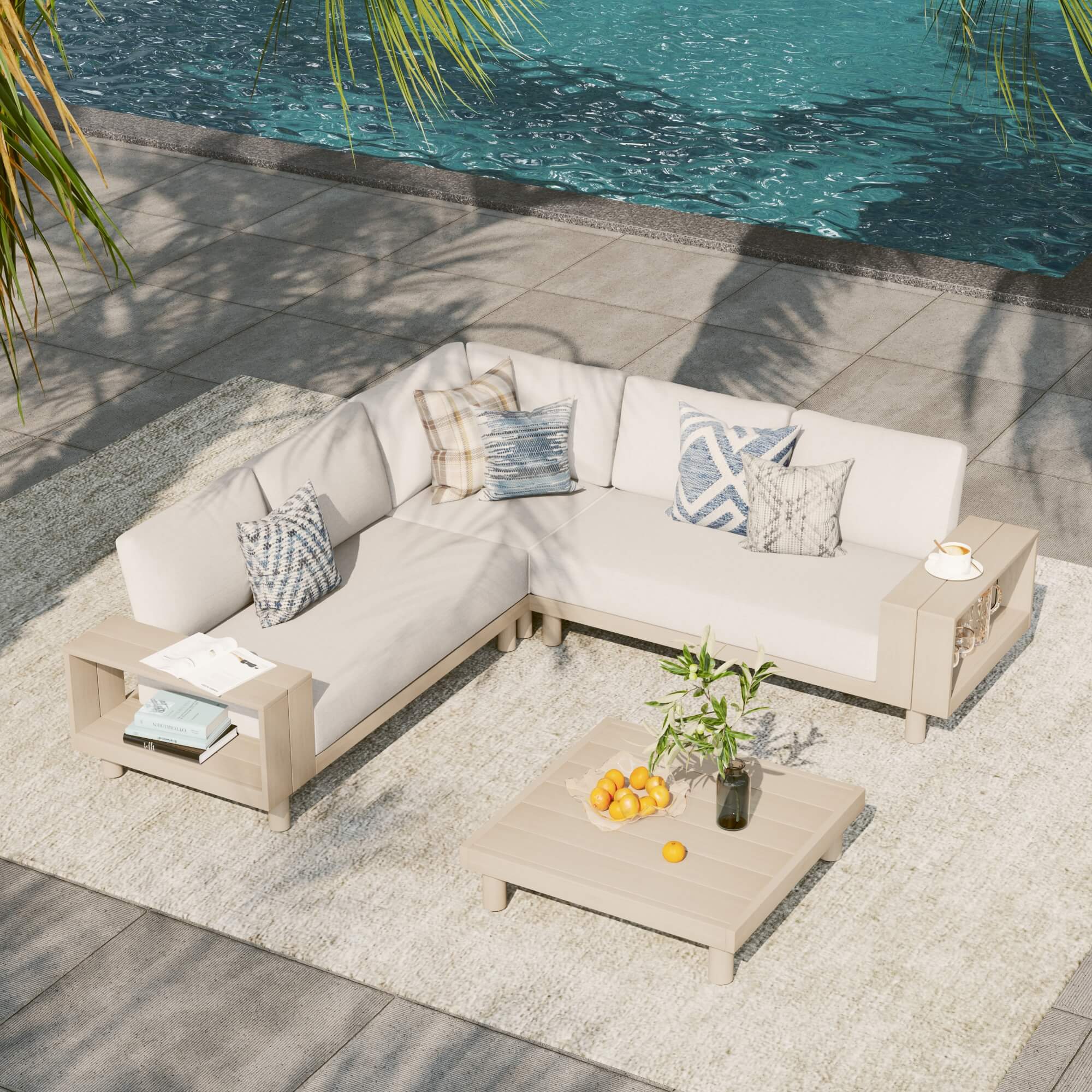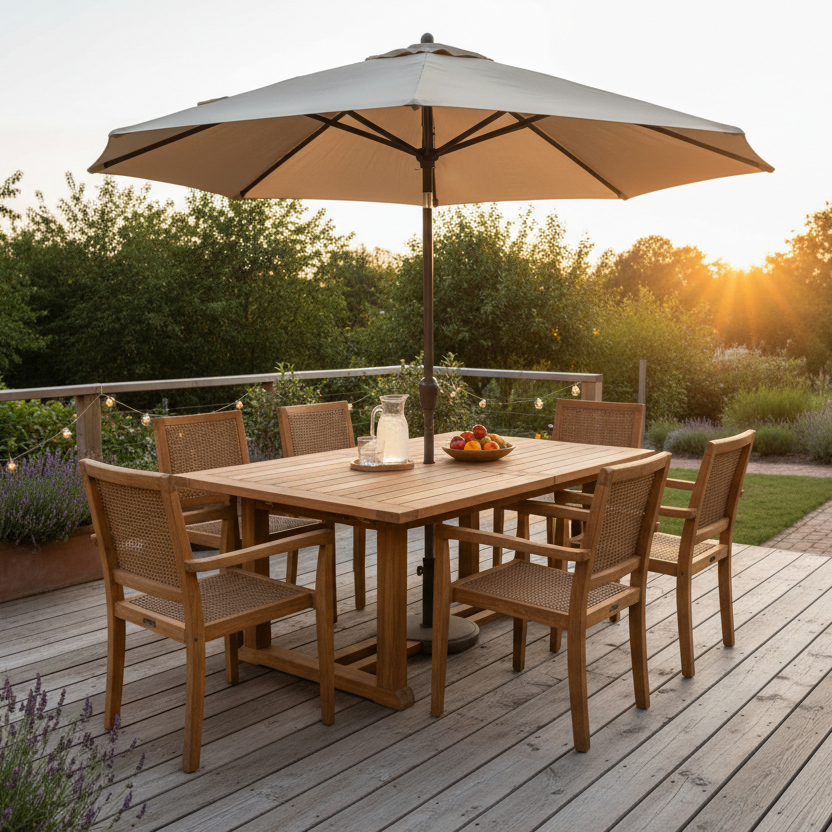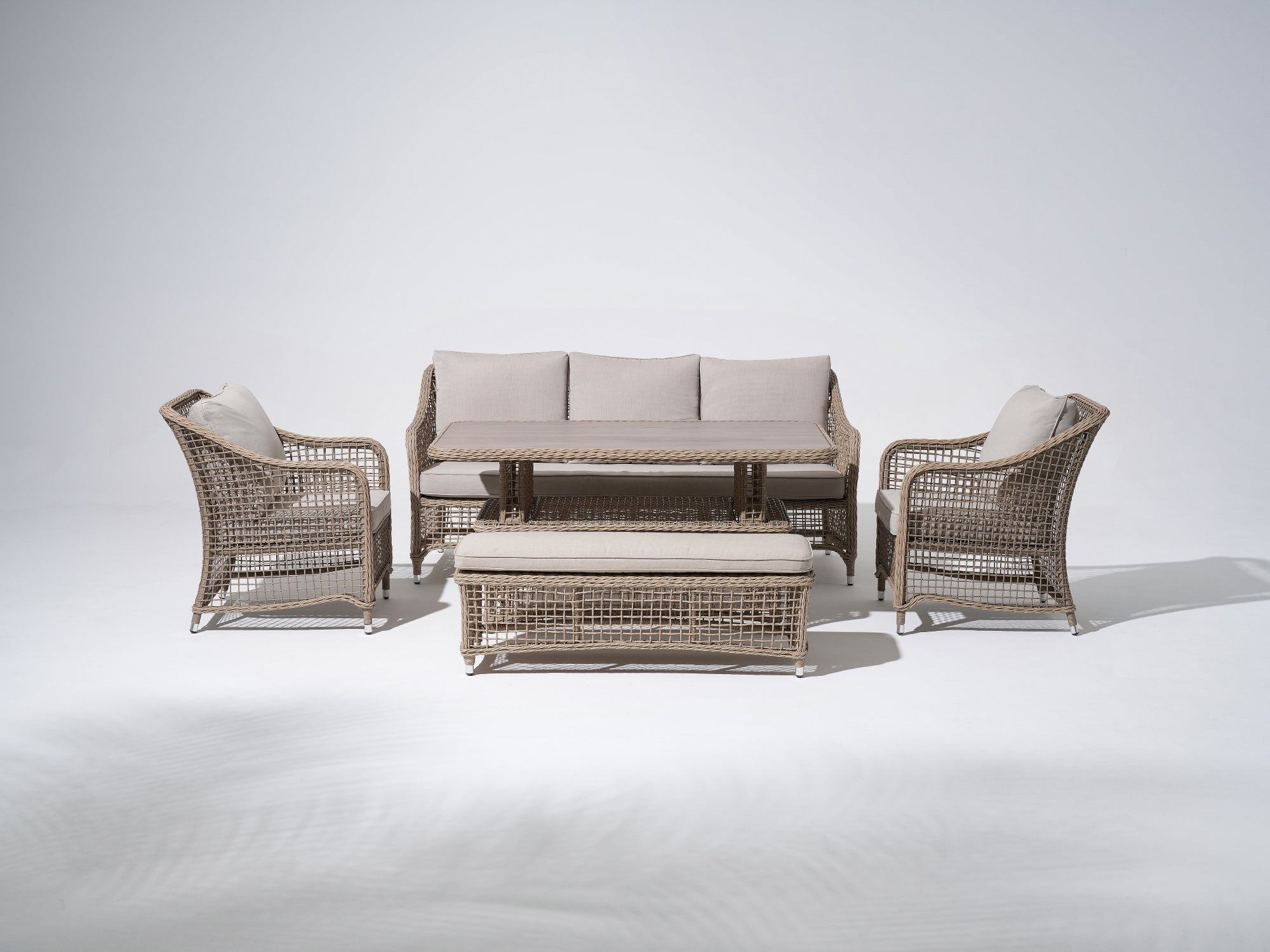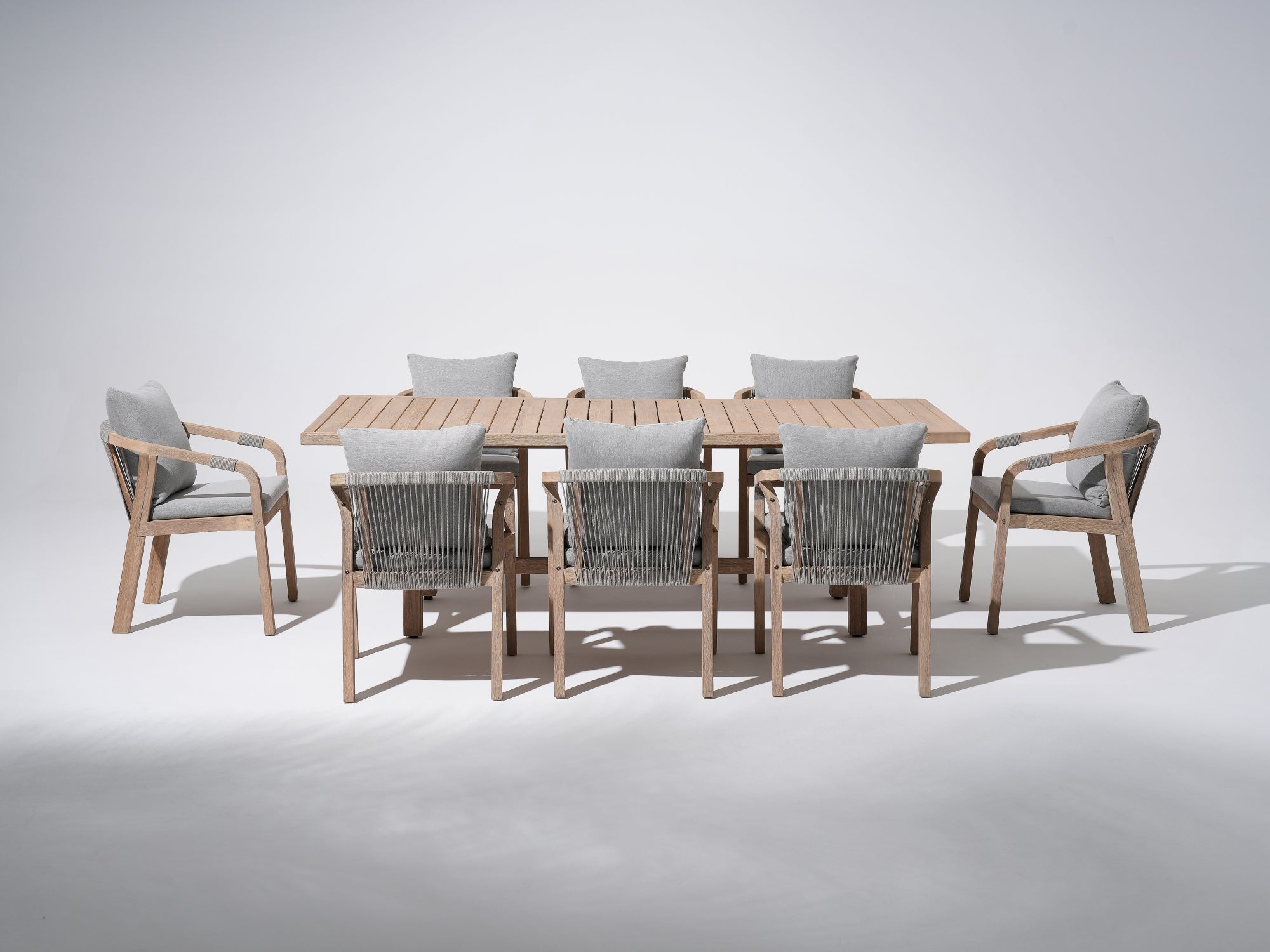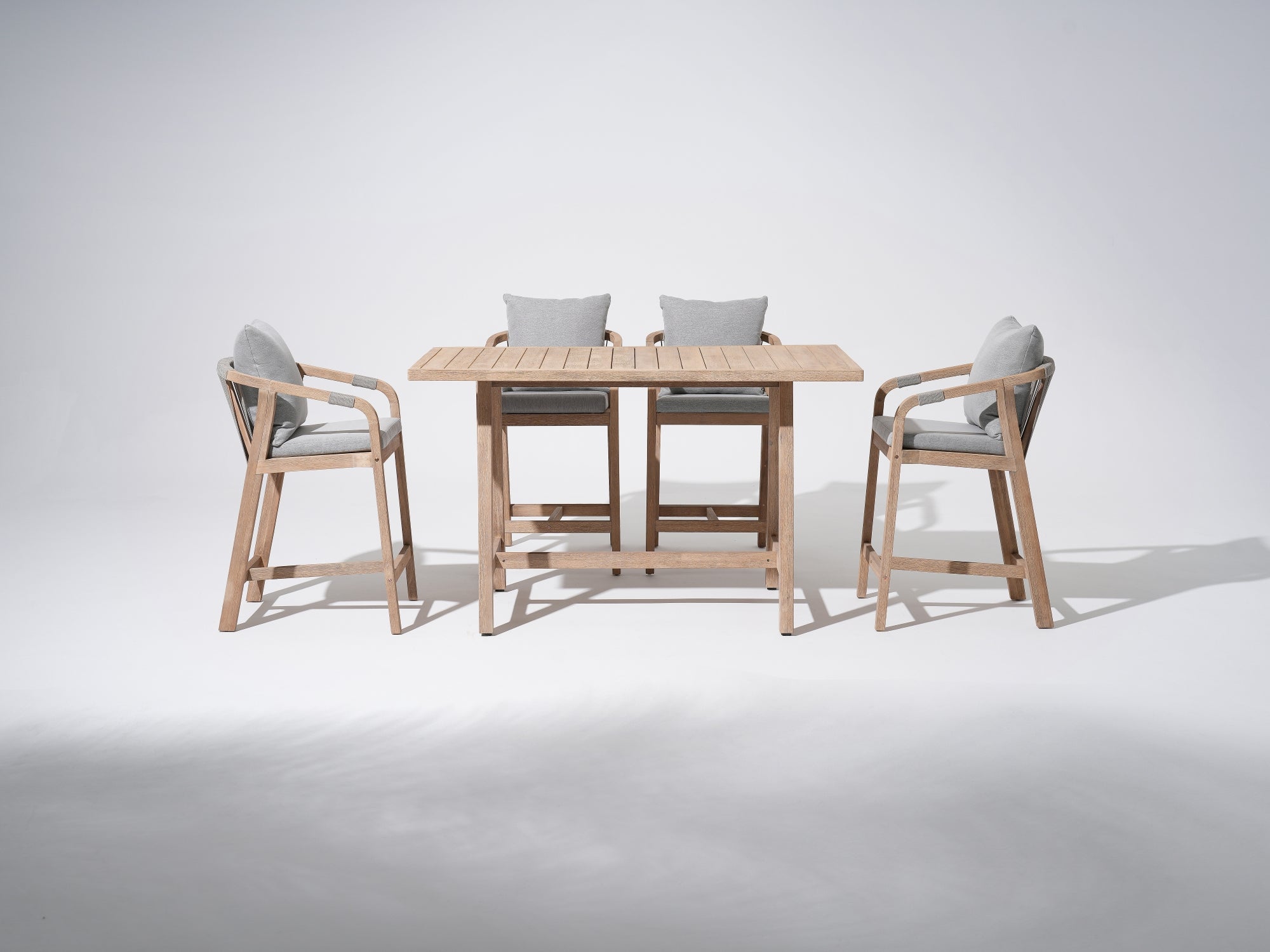Teak outdoor furniture is known for its durability and natural resistance to decay and insects. However, over time, teak furniture can still become weathered and lose its original appearance due to exposure to the elements. Restoring teak outdoor furniture can bring it back to its former beauty and extend its lifespan. Here's a step-by-step guide on how to restore teak outdoor furniture:
Tools and Materials You'll Need:
- Soft-bristled brush or scrubbing pad
- Mild dish soap or teak cleaner
- Water
- Bucket
- Garden hose or pressure washer (optional)
- Sandpaper (grit range: 100 to 400)
- Teak oil or teak sealer
- Clean cloths or brushes for applying teak oil or sealer
- Rubber gloves
- Drop cloth or plastic sheeting (to protect the work area)
Step 1: Cleaning the Teak Outdoor Furniture

- Clear the Surface: Remove any cushions or accessories from the furniture to expose the teak surface.
- Rinse the Furniture: Use a garden hose to rinse off loose debris, dust, and dirt from the teak furniture.
- Prepare Cleaning Solution: In a bucket, mix a small amount of mild dish soap with water. Alternatively, you can use a teak cleaner, following the manufacturer's instructions for the proper dilution.
- Scrub Gently: Dip the soft-bristled brush into the cleaning solution and scrub the teak furniture in the direction of the wood grain. Be gentle to avoid scratching the surface. Focus on areas with stains or grime buildup.
- Rinse Thoroughly: After scrubbing, rinse off the cleaning solution with a garden hose. Ensure there are no soap residues left on the furniture.
- Remove Stains: For stubborn stains, you can use a mixture of baking soda and water to create a paste. Apply the paste to the stain, let it sit for a while, then gently scrub it off. Rinse thoroughly afterward.
- Bleaching (Optional): Teak can naturally turn silver-gray due to exposure to the sun and weather. If you prefer to maintain the original golden-brown color, you can use a teak brightener or a teak cleaning product containing oxalic acid to help restore the color. Follow the manufacturer's instructions for usage.
- Drying: Allow the furniture to air dry completely before putting back any cushions or accessories.
Step 2: Sanding the Teak Outdoor Furniture

- Start sanding: Begin with medium-grit sandpaper (around 120 to 150 grit) to remove the gray patina and roughness. If you have an electric sander, it can speed up the process, but be careful not to sand too aggressively to avoid damaging the wood.
- Sand in the direction of the grain: Always sand teak furniture in the direction of the wood grain to prevent cross-grain scratching. This will ensure a smoother and more uniform finish.
- Smooth the surface: After the initial sanding with medium-grit paper, switch to fine-grit sandpaper (around 220 to 320 grit). This step will further smooth the surface and prepare it for finishing.
Step 3: Removing Sanding Dust

- Use a Tack Cloth: A tack cloth is a sticky cloth specifically designed to pick up and hold onto dust particles. Gently wipe the surface of the teak furniture with a tack cloth. The tack cloth will trap the fine dust and prevent it from resettling on the wood.
- Compressed Air: If you have access to an air compressor, you can use it to blow away the dust from the furniture. Hold the nozzle at a distance to avoid damaging the wood or blowing the dust back onto the surface.
- Soft Brush or Broom: Use a soft brush or broom to gently sweep away the sanding dust. Be careful not to scratch the wood surface or push the dust into the grain.
- Vacuum Cleaner: If your vacuum cleaner has a brush attachment or a low-suction option, you can use it to remove the dust from the furniture's surface. Avoid using a high-powered vacuum as it may scratch the wood.
- Damp Cloth or Sponge: Dampen a clean cloth or sponge with water and wring it out thoroughly. Gently wipe down the teak furniture to pick up any remaining dust. Make sure not to oversaturate the wood with water.
- Let it Settle: After cleaning the teak furniture, let it sit for a short while to allow any remaining dust particles to settle. Then, inspect the surface to ensure it's free from dust before proceeding with finishing or sealing.
Step 4: Applying Teak Oil or Sealer

- Choose the Right Conditions: Pick a day with good weather conditions for applying the teak oil or sealer. Ideally, the temperature should be moderate, and there should be no rain or direct sunlight, as extreme conditions can affect the application and drying process.
- Read the Product Instructions: Carefully read and follow the manufacturer's instructions on the teak oil or sealer product you are using. Different products may have specific application instructions or recommended drying times.
- Test in a Small Area: If you are unsure about how the teak oil or sealer will affect the color or appearance of your furniture, you can test it in a small, inconspicuous area before applying it to the entire piece.
- Apply the Teak Oil or Sealer: Dip a clean cloth or brush into the teak oil or sealer and start applying it to the teak furniture in the direction of the wood grain. Make sure to apply an even coat, covering the entire surface. Work in small sections at a time to prevent the product from drying before you can spread it evenly.
- Allow Absorption Time: Let the teak oil or sealer sit on the furniture for the recommended absorption time specified on the product label. This time allows the wood to absorb the oil or sealer, enhancing its natural color and protecting it from the elements.
- Additional Coats: If you want a deeper finish or extra protection, you can apply additional coats of teak oil or sealer following the same steps. Allow the first coat to soak in for about 15-30 minutes. Apply a second coat if needed to achieve the desired finish.
- Wipe Off Excess: After the absorption time, use a clean, dry cloth to wipe off any excess teak oil or sealer that has not been absorbed by the wood. Wiping off the excess ensures a smoother finish and prevents the furniture from feeling sticky.
Step 5: Allowing the Teak Furniture to Dry

- Choose a Dry and Well-Ventilated Area: Place the teak furniture in a dry and well-ventilated outdoor space. Avoid areas with high humidity or direct sunlight, as extreme conditions can affect the drying process.
- Elevate the Furniture: If possible, elevate the furniture slightly off the ground to allow air to circulate around and underneath it. This helps to speed up the drying process and prevents moisture from getting trapped.
- Use a Fan: If the weather is humid or damp, consider using a fan to improve air circulation around the furniture. This will help to expedite the drying process and prevent mold or mildew growth.
- Patience is Key: Allow the teak furniture ample time to dry naturally. It may take a few hours to a few days for the furniture to dry completely after cleaning or applying teak oil/sealer.
- Wipe off Excess Moisture: If the furniture gets wet due to rain or accidental spills, wipe off any excess moisture with a dry cloth or towel as soon as possible. This prevents water from seeping into the wood and causing damage.
- Avoid Covering Too Soon: While you might be tempted to cover the furniture for protection, avoid doing so until you are certain it's completely dry. Covering the furniture prematurely can trap moisture and lead to mold or mildew growth.
- Check for Dryness: To confirm that the teak furniture is dry, touch the surface and edges to ensure there is no lingering dampness. You can also use a moisture meter to check the wood's moisture content, especially for larger pieces or if you live in a particularly humid climate.
Step 6: Regular Maintenance

- Cleaning: Regularly clean the teak furniture to remove dirt, dust, and grime. You can use a soft-bristle brush or a sponge with mild soapy water (use a gentle dish soap) to clean the surface. Avoid using harsh chemicals, bleach, or abrasive cleaners, as they can damage the wood's natural oils.
- Preventing Stains: To prevent stains from food, drink spills, or bird droppings, promptly clean any spills or messes as they occur. You can also place coasters or placemats under glasses and dishes to protect the teak furniture's surface.
- Removing Mildew or Mold: In humid or damp environments, teak furniture may develop mildew or mold. Mix equal parts water and white vinegar or use a mildew cleaner specifically designed for wood. Apply the solution to the affected areas and gently scrub with a soft brush. Rinse thoroughly and allow the furniture to dry completely.
- Regular Inspections: Periodically inspect your teak outdoor furniture for any signs of damage, loose joints, or cracks. Address any issues immediately to prevent further damage.
- Covering or Storing: If possible, cover your teak furniture during extended periods of non-use or harsh weather conditions. Use a breathable furniture cover to prevent moisture buildup and mold growth. If you live in an area with harsh winters, consider storing the furniture indoors during the off-season to protect it from extreme cold and snow.
Keep in mind that some people prefer to let their teak furniture age naturally and develop a silver-gray patina over time. If you like this look, you can skip the teak oil or sealer and focus on regular cleaning and maintenance.
----------------------------------------
Based on the weather conditions in your region, you may only need to perform annual maintenance every few years. I recommend refreshing your teak outdoor furniture every early spring to keep it looking beautiful for a long time!
I hope these tips help you in your journey to restore your old teak furniture. If you're considering replacing your old teak furniture, here are some new teak furniture sets that you might like!


